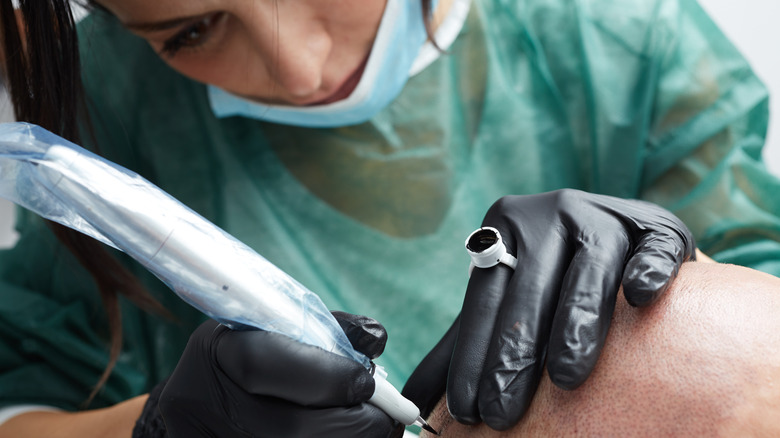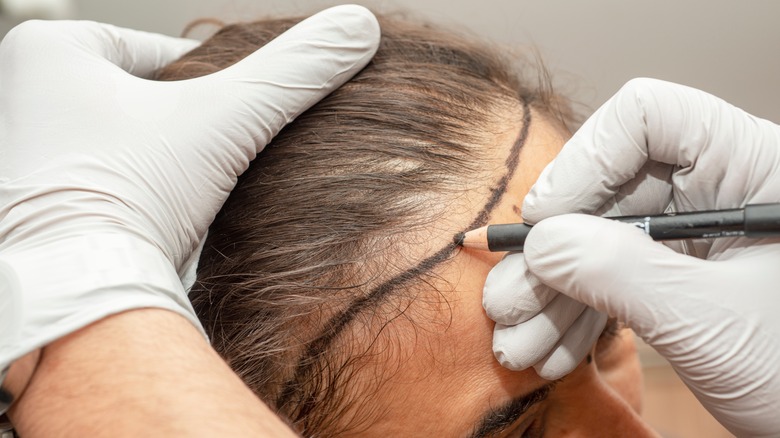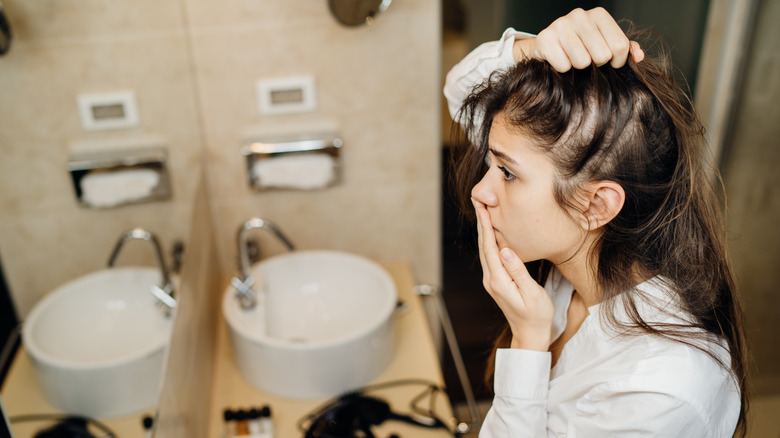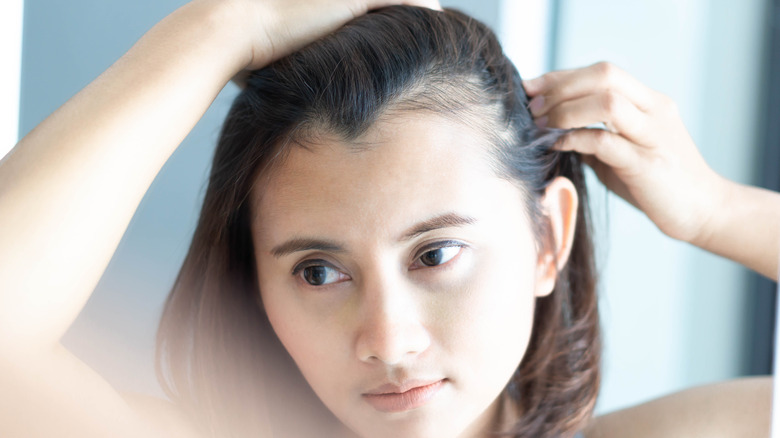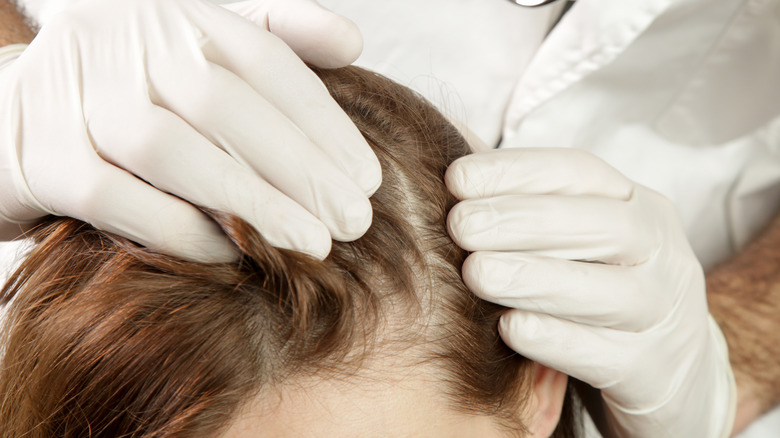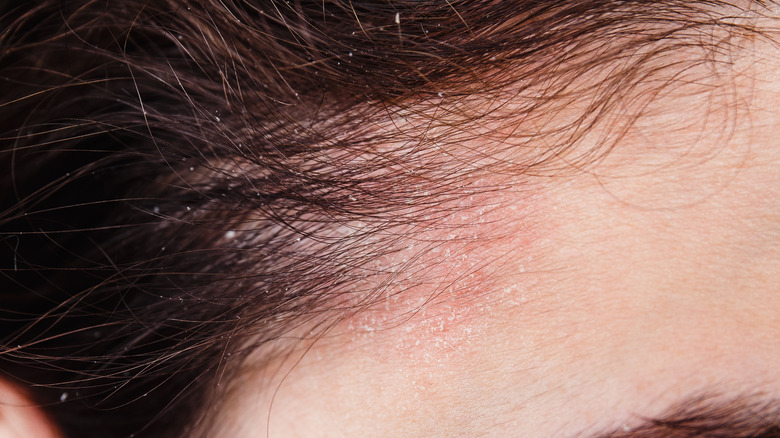Scalp Micropigmentation: What Is It, And Does It Actually Make Your Thin Hair Look Fuller?
Grace Jones' legendary cropped hairdo and Sinead O'Connor's trendy 90's buzz cut remain classic examples of women who don't require long, luscious locks to feel confident and beautiful. However, the need to sport a shaved scalp doesn't always stem from a place of female empowerment and liberation. Many women who experience hair loss, for instance, typically struggle to grow thick locks due to hair thinning. According to the Cleveland Clinic, hair loss affects upwards of 50% of women in the United States, but it manifests differently depending on the individual. In general, common symptoms of hair loss include thinning, patchy bald spots, or even complete baldness.
Thankfully, this is where scalp tattooing comes into play. Scalp micropigmentation (SMP) is a cosmetic tattoo procedure that is quickly becoming the go-to solution for hair loss as it creates the illusion of a full head of hair. Here's everything you need to know about this innovative treatment before you jump in head first — pun intended.
What is scalp micropigmentation (SMP)?
The top causes for hair loss include female-pattern hair loss (FPHL) or androgenetic alopecia, chronic stress, vitamin or mineral deficiencies, chemical damage, and extreme dieting, via the Cleveland Clinic. Hair loss also occurs as a side-effect of medications, skin conditions, cancer treatments, or hormonal conditions such as polycystic ovary syndrome (PCOS), per the American Academy of Dermatology Association. For those with alopecia or receding hairlines, undergoing scalp micropigmentation allows those with alopecia or thinning to reclaim their confidence and self-esteem.
"Scalp micropigmentation treatment is the art of using pointillism to deposit micro-sized pigment into the scalp in order to replicate the illusion of a hair follicle," Jonathan Gerow, co-founder of New York-based Gerow Hair Ink, tells Glam. To treat hair loss symptoms, an SMP expert uses a tattoo device designed for applying permanent makeup. However, the specialized three-point SMP microneedle only penetrates two layers of skin, whereas a traditional tattoo needle injects ink about five layers deep into the skin, per Elix Beauty.
How does it compare?
Those with severe hair loss often invest time and effort into alternative hair growth methods or accessories. Some individuals experiment with over-the-counter restoration products such as oral medication and prescription shampoos, while others rely on wigs to conceal baldness or bald spots. That said, side effects are common with any medication. According to the Mayo Clinic, medicated shampoos that target hair loss often incur irritation or unwanted hair growth in neighboring areas. Oral medications used to treat hair loss, including spironolactone and dutasteride, sometimes lead to symptoms such as chest discomfort, peeling skin, and dizziness, per the National Health Service (NHS).
When people exhaust all other options, they turn to hair transplant surgery. According to the American Society of Plastic Surgeons, however, the outcome of transplant surgeries leans toward unpredictability, and the potential risks include scarring, infection, patchiness, and repeat surgery. However, many individuals experience success with hair transplants, the cost and recovery time act as significant barriers, especially for those who can't afford to take time off work to heal (via the Wimpole Clinic).
In comparison, scalp micropigmentation remains a more affordable option in terms of both cost and recovery. As a non-invasive hair loss method, SMP requires little to no downtime with a short and hassle-free recovery process, per the Cleveland Clinic.
SMP and long hair
Scalp micropigmentation mainly targets balding, buzz cuts, and short hair. But does this treatment also help fill bald spots for clients with longer hair? Yes, absolutely. Those with medium to long hair who notice patchy growth due to alopecia or hormonal hair loss equally benefit from SMP. "If you have thinning hair, SMP can be used to create the illusion of greater density," Jonathan Gerow shares with Glam. "The specialist can apply the pigment in areas where the hair is thinning, making it look like there are more hair follicles in that area."
In this case, experts make the hair appear fuller by using a specific tattooing technique to create thin, brush-like strokes to imitate the growth of individual hairs. SMP specialists also adjust the color of the pigment to match your natural hair color while taking your skin tone into account to ensure the treatment areas don't seem glaringly obvious.
What to expect
A typical experience with SMP involves an initial consultation where you discuss your expectations and ask questions before moving forward. During this process, you will collaborate with your specialist to achieve your desired look while your SMP specialist considers your existing hair growth to outline a design that features your ideal hairline and density. Following the consultation, your specialist will explain the necessary steps and precautions to prepare for your appointment, such as abstaining from certain medications and alcohol for at least 48 hours before your session. Your SMP expert may also recommend that you exfoliate and moisturize several days before treatment to enhance the ink's absorption into the skin.
On the day of your appointment, "The specialist will work carefully and precisely to create the desired look, ensuring that the dots are evenly spaced and aligned with your natural hairline," according to Jonathan Gerow. The length of the procedure depends on the scale of the treatment area, and you may require multiple sessions. Prices also vary depending on the specific treatment area and individual specialist, though the average cost ranges between $300 and $3,500.
Is it safe?
The risks of non-invasive procedures such as SMP are rarely severe. Unlike other hair loss methods, such as transplant surgery and oral medication, the potential risks are minimal and easily avoided. For instance, "There is a risk of infection with any procedure that breaks the skin, including SMP," Jonathan Gerow warns. "Your specialist should follow strict sterile techniques to minimize the risk of infection." You can also experience allergic reactions to the ink, which affects treatment and healing. Therefore, those with sensitive skin are encouraged to inform their SMP specialist of any previous reactions.
Before proceeding with treatment, ensure your SMP specialist is licensed and experienced. Look for examples of previous work on their website or social media page to avoid choosing an SMP technician with poor technique, as you may walk away with unsatisfactory results. A skilled SMP specialist strives to create a natural look that blends the ink with natural hairs without signs of blotchiness and uneven lines. Conducting appropriate research before moving forward will prevent a botched procedure.
Who can benefit from SMP?
Most people pass the eligibility requirements for SMP treatment, which typically involves the initial consultation and, in some cases, an examination of your scalp prior to treatment. The ideal candidates for SMP include anyone experiencing thinning or baldness due to alopecia, male or female pattern baldness, or scarring that inhibits hair growth. Suitable candidates also include those ineligible for hair transplant surgery due to lacking hair follicles.
That said, "SMP is not recommended for people with certain medical conditions," Jonathan Gerow explains. For instance, bleeding disorders and skin conditions that affect the scalp, such as psoriasis and eczema, increase the risk of complications, particularly during a flare-up (via Healthline). Similarly, avoid SMP if you develop keloid or raised scars, per Healthline. Those with pre-existing medical conditions or a weakened immune system should also consult a doctor prior to SMP treatment, as it may affect the recovery process.
Aftercare and maintenance
Your SMP technician will provide specific instructions to encourage healing, but as a general rule, you should avoid direct water contact for at least four days to prevent infection. Touching the treatment areas after your appointment is also discouraged. If you need to apply a healing ointment, wash your hands beforehand to avoid spreading bacteria and increasing the risk of infection.
To maintain long-lasting results, regular sun protection is critical. "Sun exposure can cause the pigment to fade or discolor, so it's important to wear a hat or sunscreen with a high SPF to protect the scalp from the sun," Jonathan Gerow tells Glam. Try not to venture into the sun at least thirty days after your appointment for the best results. You don't need to isolate yourself, but remember to reapply your sunscreen every two hours whenever you go out. If possible, consider undergoing treatment during the fall or winter months. Gerow also recommends restricting "physical activity or strenuous exercise for at least 4 days after the procedure." The results last up to eight years, but frequent sun exposure and sweating break down the pigment.
SMP easily outcompetes other hair loss treatments regarding low-maintenance aftercare and longevity. With minimal risks and fabulous results, this cosmetic treatment is undeniably, worth every cent to mask the effects of thinning.

